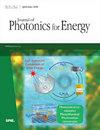Techno-economic analysis of a solar thermophotovoltaic system for a residential building
IF 2.1
4区 工程技术
Q4 MATERIALS SCIENCE, MULTIDISCIPLINARY
引用次数: 0
Abstract
Thermophotovoltaics (TPV) is a technology that converts heat to electricity using a thermal emitter and a matched photovoltaic (PV) cell. TPV is becoming increasingly popular due to its advantages of silent power generation, higher power density (>2.5 W/cm2), reduced cost, no moving parts (thus, low maintenance costs), reaching full power in less time as compared to turbines, operating at high temperatures, and suitability for long-duration energy storage applications. This study conducts a techno-economic analysis (TEA) of a solar energy conversion (using TPV) and storage system (using phase-change materials). We optimize the levelized cost of consumed energy (LCOE) and electricity (LCOEel) using the Nelder-Mead algorithm for four scenarios (as identified in the reference study). These scenarios differ in nominal-weighted average cost of capital (WACCnom), fuel and electricity inflation rate, and capital cost factor (CAPEX) of high-temperature energy storage (HTES), power generation unit (PGU), and PV systems. We perform a sensitivity analysis that predicts a modest decrease in LCOE and LCOEel from the mean values of $0.038/kWh and $0.128/kWh, respectively. We perform a Monte Carlo uncertainty assessment and fit a probability distribution based on input variables’ historical data from the literature. The fitted probability distribution for outputs (mean, the standard deviation in brackets) is LCOE ($/kWh)—general extreme value (0.035, 0.009), and LCOEel ($/kWh)—t (0.132, 0.016). The reduced mean values for the optimized system indicate a massive potential for TPV to be economically feasible; however, the LCOEel is higher than the current average electricity price of $0.124/kWh. The box plot shows that lifetime, PV CAPEX, inflation rate, natural gas price, and WACCnom significantly impact LCOE, and future research focused on them would lead to a better adoption of TPV technology.住宅楼太阳能光热发电系统的技术经济分析
热光电(TPV)是一种利用热发射器和匹配的光伏(PV)电池将热能转化为电能的技术。由于其具有静音发电、功率密度更高(>2.5 W/cm2)、成本更低、无活动部件(因此维护成本低)、与涡轮机相比可在更短时间内达到满功率、可在高温下运行以及适合长时间储能应用等优点,冠捷光伏技术正变得越来越受欢迎。本研究对太阳能转换(使用热塑性硫化弹性体)和储能系统(使用相变材料)进行了技术经济分析(TEA)。我们使用 Nelder-Mead 算法对四种方案(如参考研究中确定的方案)的平准化能源消耗成本(LCOE)和电力成本(LCOEel)进行了优化。这些情景在名义加权平均资本成本 (WACCnom)、燃料和电力通胀率以及高温储能 (HTES)、发电装置 (PGU) 和光伏系统的资本成本系数 (CAPEX) 方面各不相同。我们进行了一项敏感性分析,预测 LCOE 和 LCOEel 将分别从 0.038 美元/千瓦时和 0.128 美元/千瓦时的平均值略有下降。我们进行了蒙特卡罗不确定性评估,并根据文献中输入变量的历史数据拟合了一个概率分布。拟合的输出概率分布(均值,括号内为标准差)为 LCOE($/kWh)-一般极值(0.035,0.009)和 LCOEel($/kWh)-t(0.132,0.016)。优化系统平均值的降低表明,冠捷光伏具有巨大的经济可行性潜力;然而,LCOEel 高于当前 0.124 美元/千瓦时的平均电价。方框图显示,寿命、光伏资本支出、通货膨胀率、天然气价格和加权平均资本成本对 LCOE 有重大影响,未来针对这些因素的研究将有助于更好地采用冠捷技术。
本文章由计算机程序翻译,如有差异,请以英文原文为准。
求助全文
约1分钟内获得全文
求助全文
来源期刊

Journal of Photonics for Energy
MATERIALS SCIENCE, MULTIDISCIPLINARY-OPTICS
CiteScore
3.20
自引率
5.90%
发文量
28
审稿时长
>12 weeks
期刊介绍:
The Journal of Photonics for Energy publishes peer-reviewed papers covering fundamental and applied research areas focused on the applications of photonics for renewable energy harvesting, conversion, storage, distribution, monitoring, consumption, and efficient usage.
 求助内容:
求助内容: 应助结果提醒方式:
应助结果提醒方式:


